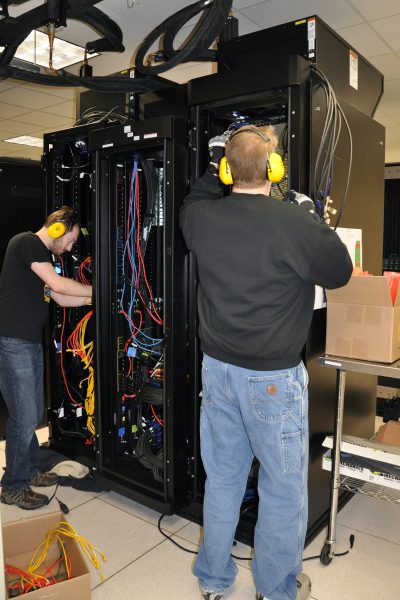Flexible Chinook computer does more with less power
December 11, 2017
LJ Evans
907-474-2737

A computer named Chinook has made scientific calculation at the University of Alaska Fairbanks faster and more flexible while saving more than $100,000 a year in electricity.
鈥淐hinook is saving about $12,000 in electricity costs monthly compared to two years ago, and at the same time providing a more powerful high-performance computer system than the two it replaced,鈥� said Gwen Bryson, manager of Research Computing Systems at the 性欲社 Geophysical Institute.
The Penguin Computing cluster was chosen to meet 性欲社鈥檚 research needs because it鈥檚 big, fast and can be added to as needed 鈥� and because it eats far less energy than 性欲社's prior HPC systems, Bryson said.
Chinook is a community 鈥渃ondo鈥� model high-performance computer cluster. It鈥檚 called that because common infrastructure elements such as racks and networking are shared and allow researchers to use their own funding to add computing segments, called nodes, to the system.
This kind of system is in some ways like owning a unit in a condominium building, sharing maintenance and associated fees with the other residents, Bryson said.
性欲社 scientists use Chinook to research enormous problems such as seismic wave propagation in the Earth, ozone transport in the polar regions and space plasma physics.
鈥淏y sharing common elements and pooling computing nodes, researchers gain access to a larger system than they could purchase individually and are able to focus their time on science, rather than computer administration,鈥� Bryson said.
Modeling how earthquakes move through the ground
Carl Tape, associate professor of geophysics in the Geophysical Institute and the Department of Geosciences, conducts research on with the goal of developing 3-D models of the Earth鈥檚 subsurface crust and upper mantle.
Seismic tomography is a technique for imaging the subsurface of the Earth using seismographic data about waves produced by earthquakes or explosions. These waves travel through the Earth鈥檚 layers, causing the movement of land and structures we experience when there鈥檚 an earthquake. Seismic waves can also originate from volcanic eruptions, magma movement, large landslides or large manmade explosions that give out low-frequency acoustic energy.
鈥淭he Earth is complicated,鈥� Tape said. 鈥淲ithout high-performance computing, you could never convey the level of realistic details鈥� in graphics and videos scientists use to analyze their data.
Tape said there are basically two approaches to solving huge computational problems like these. Scientists can perform their earthquake simulations at a national computing center, where there might be a couple hundred other researchers in the queue, or the computational work can be done by a local center, such as Research Computing Systems at the GI.
鈥淭he advantage to doing the computations locally is the speed of transferring massive files and the presence of experts here committed to your needs,鈥� Tape said. 鈥淓ven though I grew up in Fairbanks, I would not have applied for a job here unless this kind of high-performance computing resource was available.鈥�
How Chinook is different
Chinook鈥檚 community condo model is a significant change in how high-performance computing resources are made available to the UA community, Bryson said.
鈥淧reviously, HPC was fully subsidized by federal agencies,鈥� Bryson said. 鈥淭oday it鈥檚 a collaboration among many UA entities, researchers and supporters.鈥�
Researchers who contribute nodes to the system receive priority access to the cluster for a duration that aligns with the hardware warranty of the nodes they purchased. When the warranty expires, the researcher still has access to Chinook, but at a lower priority, Bryson said.
鈥淭his approach further improves the efficiency of Chinook by implementing node life-cycle management,鈥� Bryson said. 鈥淎s older nodes are retired from service, space is created in the computer racks for new nodes to be brought online, but only if needed and purchased.鈥�
Chinook is significantly more capable than previous, legacy HPC systems at 性欲社, Bryson said.
鈥淎 job executed on Chinook runs in less than half the time as the same job executed on the university鈥檚 legacy HPC systems,鈥� Bryson said.
Chinook came online in January 2016. Funding for its original installation and a recent expansion came from the M.J. Murdock Charitable Trust in a partnership with the Geophysical Institute, 性欲社 vice chancellor for research, 性欲社 International Arctic Research Center and 性欲社 IDeA Network of Biomedical Research Excellence.
More than 150 researchers and students use Chinook, consistently employing over 80 percent of the system, Bryson said.
鈥淚n HPC terms, that indicates a very busy and well-utilized system,鈥� she said.
The new system seems to be meeting researchers鈥� needs.
鈥淚鈥檝e been very happy so far,鈥� Tape said, an attitude that Bryson said is generally echoed by the other scientists using Chinook.
鈥淲e can expand Chinook as the research community dictates and university funding or agency can support,鈥� Bryson said. 鈥淭his flexibility, along with the significant savings in the costs to power the system, is the big plus.鈥�


